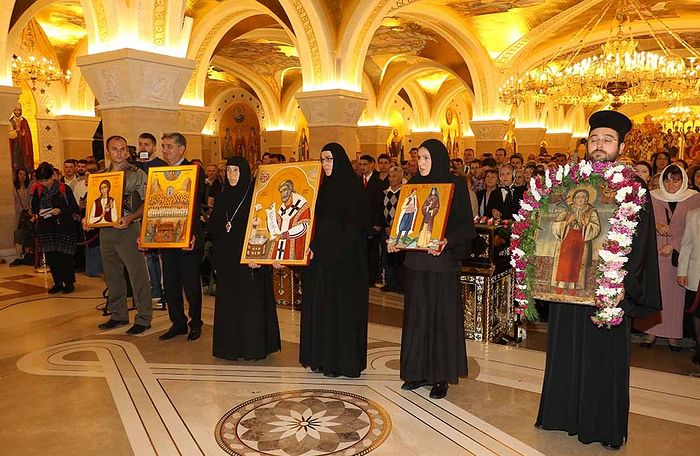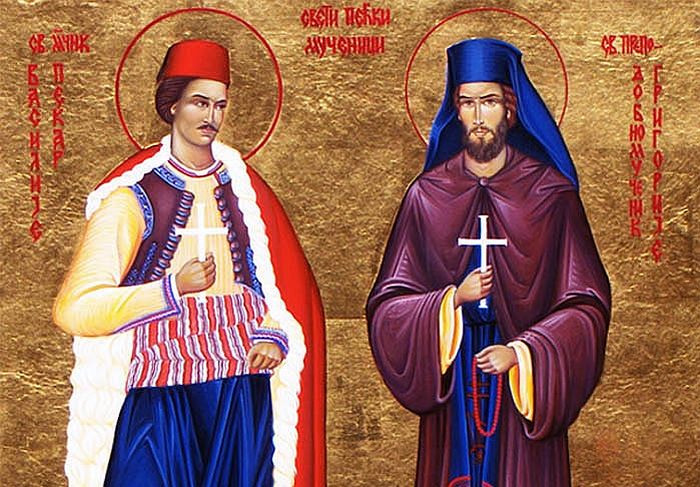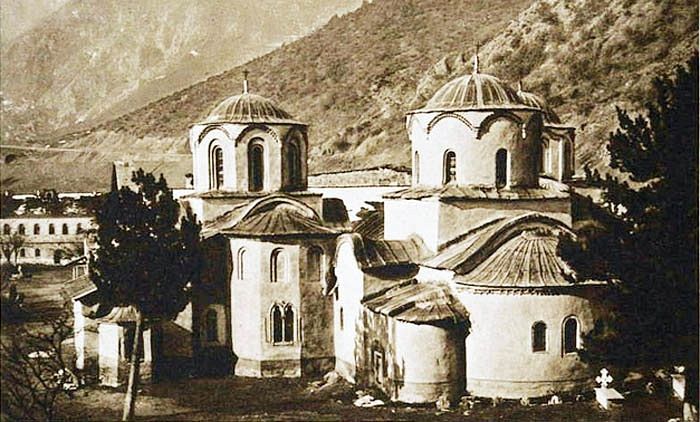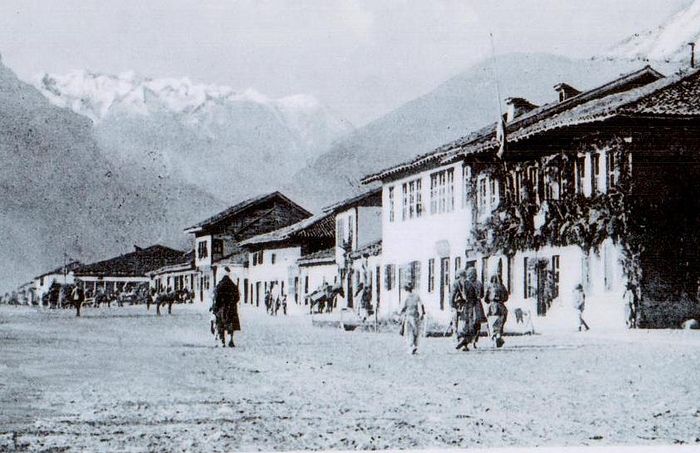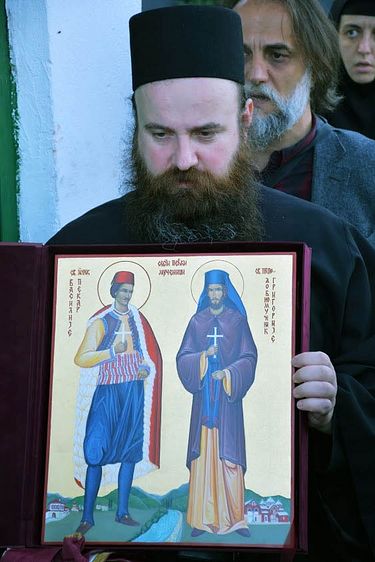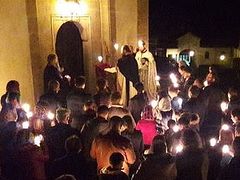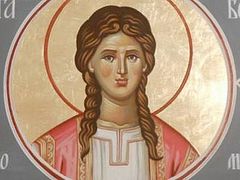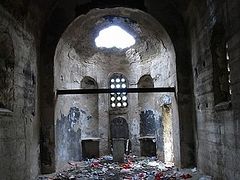In May 2018, the Holy Synod of the Serbian Orthodox Church canonized three monastic-martyrs of Christ who suffered under the Turkish Yoke: Monk Grigorije of Peć, Monk Vasilije the baker of Peć, and the virgin Bosiljka from Pasjana. The solemn glorification of the new saints was held in the Church of St. Sava on May 10, 2018, during the Divine Liturgy on the day of the burning of the relics of St. Sava.
Thus, the Serbian Orthodox Church ratified the long-standing prayerful veneration of the newly-glorified holy martyrs among the faithful of the Serbian people, firstly of Kosovo and Metohija, where they suffered.
In these days, where the suffering of the Serbian Orthodox people in Kosovo and Metohija continues, the glorification of these martyrs was a great consolation and support for the faithful and a reminder to Serbs that their forefathers were ready to lay down their lives for the name of Christ.
Today we will acquaint you with the podvig of one of the newly-glorified saints—the holy Monk-Martyr Grigorije, a monk of Peć.
***
St. Grigorije of Peć lived during the Turkish yoke and was a brother of the great lavra of the Peć Patriarchate in Metohija. Information about whether he was a simple monk or whether he bore some sort of ecclesial rank has not survived to our day. The date and place of his birth is also unknown, but the memory of his ascetical life, offered as a gift to the Lord, is preserved among the faithful to our day. It’s also known that soon after his martyric death, the Lord glorified Grigorije with the gift of miracles.
Presumably, St. Grigorije was born in Peć or a surrounding area, and suffered for Christ in the seventeenth or eighteenth century. In the words of the chronicler, it was a time when “the weeping and wailing of the exhausted Serbian soul, lamenting under the hand of evil, tore the heavens… Everything stopped and wept under the feet of the tyrant.” In those difficult times, the Serbian clergy were the teachers, leaders, refuge, and consolation for the people; they encouraged them in faith, patience, and hope for the longed-for freedom.
St. Grigorije was endowed with unusual beauty—and not just bodily, but firstly beauty of soul, fully directed towards God, adorned with piety and fiery faith.
The Turks perfectly well understood that such Christians are the salt of the earth and the light of the world, and fervently sought to persuade them to Mohammedanism by kindness or force, hoping that many would follow the example of these noble people. Grigorije knew this well, and therefore he tried to never stand out or catch the eye of a Turk unnecessarily. Even in his hometown, he would always sneak along in a roundabout way, and at a time of day when there were few people on the street.
Nevertheless, Grigorije did not remain unnoticed by the Turks. He received special attention from the daughter of a famous and notable Turk, according to some evidence from the Pasha of Peć himself. The girl was captivated by passion for this beautiful ascetic, and her father and his associates came up with a treacherous plan to convert the monk Grigorije to Mohammedanism. A convenient opportunity presented itself to them when Grigorije headed for the market in Peć for some necessities for the monastery. The Turks intentionally caused a small rebellion, and during the excitement, they seized the young monk and led him to a qadi—a judge.
At first they tried to seduce the ascetic, promising him a high position in the Turkish administration in the event that he would accept Islam and marry the Pasha’s daughter, but when they saw that the monk did not want to hear about it, they switched to threats of horrible torments. The young solder of Christ remained steadfast. Then, seeing the firmness of his faith and the powerlessness of their persuasions, the Turks forcefully circumcised Grigorije, believing he would thereby be converted to Islam. What tortures Grigorije endured is known to God alone. However, they could not shake him.
Knowing full well that the hour of his confession had come, and having been set free, he immediately threw off his Turkish robe and clothed himself in a tattered monastic mantia. He began to openly and loudly denounce the false faith of Mohammed and Turkish lawlessness. This enraged the Turks, and they began to beat and torture Grigorije. Eventually, one of the torturers cleaved his stomach with a sharp knife, and mortally wounded him, then left him to die on the street. Having gathered his last strength, Grigorije reached the nearest Serbian home, and on its threshold, gave up his soul to the Lord.
The Turks ordered his body to be disposed of far away, but the Serbs secretly buried him near the city (this region is now the center of Peć), and a small stone slab was placed on the site of his burial without any inscription. Over time, miracles began to occur at Grigorije’s grave, and the faithful, constantly flocking to it, erected a small stone chapel.
The feast of the holy Monk-Martyr Grigorije was celebrated on the commemoration of his Heavenly patron and protector, St. Gregory the Theologian (January 25/February 7). It became a sacred feast in Peć, and none of the Christians would work that day. The residents of Peć Viktoria Stanevic and Blaženka Chukic heard about this from their elders, and Milunka Lazovic remembers the place where the church was.
The memory of St. Grigorije continued to live in the people in the following centuries, although the conditions were not always favorable for the people’s piety. The humble church on the martyr’s grave survived Turkish rule, but in the Kingdom of Yugoslavia, the state administration, detached from the people’s traditions and intoxicated by a pernicious secular spirit, decided to build an agricultural institute on the site where the church was located. This mindless project was realized, and the small church with the ascetic’s grave wound up in immediate proximity to the institute’s building, constrained in an unbecoming way.
The godless bureaucracy did not rest on their laurels, but decided to fully destroy the church. Some workers were especially assigned to perform this unseemly task. However, according to the testimony of the older Peć inhabitants, the majority of them immediately took leave of their senses, and the work had to stop. After that, unable to find others who desired to work, the organizers offered the work to the Gypsies. But having understood what was going on and seeing what happened to their predecessors, they refused the offer, saying “we are people too.” In the end, they brought in a group of prisoners from somewhere who had no idea what awaited them. They quickly dismantled the old dilapidated church, during which they opened the grave of the holy martyr. At a depth of ten feet, they found his remains and fresh blood as if shed the day before.
According to the older residents, the martyr’s remains were most likely transferred to the Peć Patriarchate for preservation together with the relics of many other holy ascetics, whose names are known only to the Lord.
The destruction of the church and the removal of St. Grigorije’s remains took place in 1929, but the faithful continued going to the site to pray all the way up through the 1970s. Thus, Mitra Miyatovic of Peć (born in 1934, living in the Peć Patriarchate), whose mother often took her to the site, today well remembers the wondrous fragrance of the lilacs growing there. Over time, due to political changes, this tradition was broken, but a strong memory of the holy Martyr Grigorije was preserved among the Serbs of Peć.
Many miracles occurred at the saint’s grave, and they did not stop later when his veneration was no longer connected with that particular site. According to Dragi Radoicic (1928-2016 +), they would pray to St. Grigorije for any need, but especially for children with problems talking and walking. This is verified by the miraculous healing of one girl in the middle of the twentieth century who was mute and paralyzed until she was six, but after prayer to St. Grigorije began to walk and talk. There was a special custom where she would circle the saint’s grave with the sick three times in the name of the Holy Trinity, censing, with a lit candle.
The veneration of St. Grigorije is first described by the Serbian historian and academician George Radoicic, and after him, short notes about it are found in the theologian and historian Leonty Pavlovic (Cults of the Serbs and Macedonians) and Hieromonk Dimitry Plecevic’s Serbian Paterikon, which contains testimony of the existence of the church and grave, and the date of the destruction of the church and the removal of the saint’s earthly remains is specified. Both of these authors indicate that the holy Martyr Grigorije was revered by both Christians and Muslims.
The pure sacrifice of St. Grigorije brought plentiful fruit for the glory of God, which explains why his memory and the veneration of this wondrous fragrant flower of the garden of the Lord did not disappear despite the centuries dividing us from his martyric suffering, and despite the destruction of his shrine.
By the prayers of the holy Monk-Martyr Grigorije of Peć the wonderworker, Lord Jesus Christ our God, have mercy on us. Amen!

